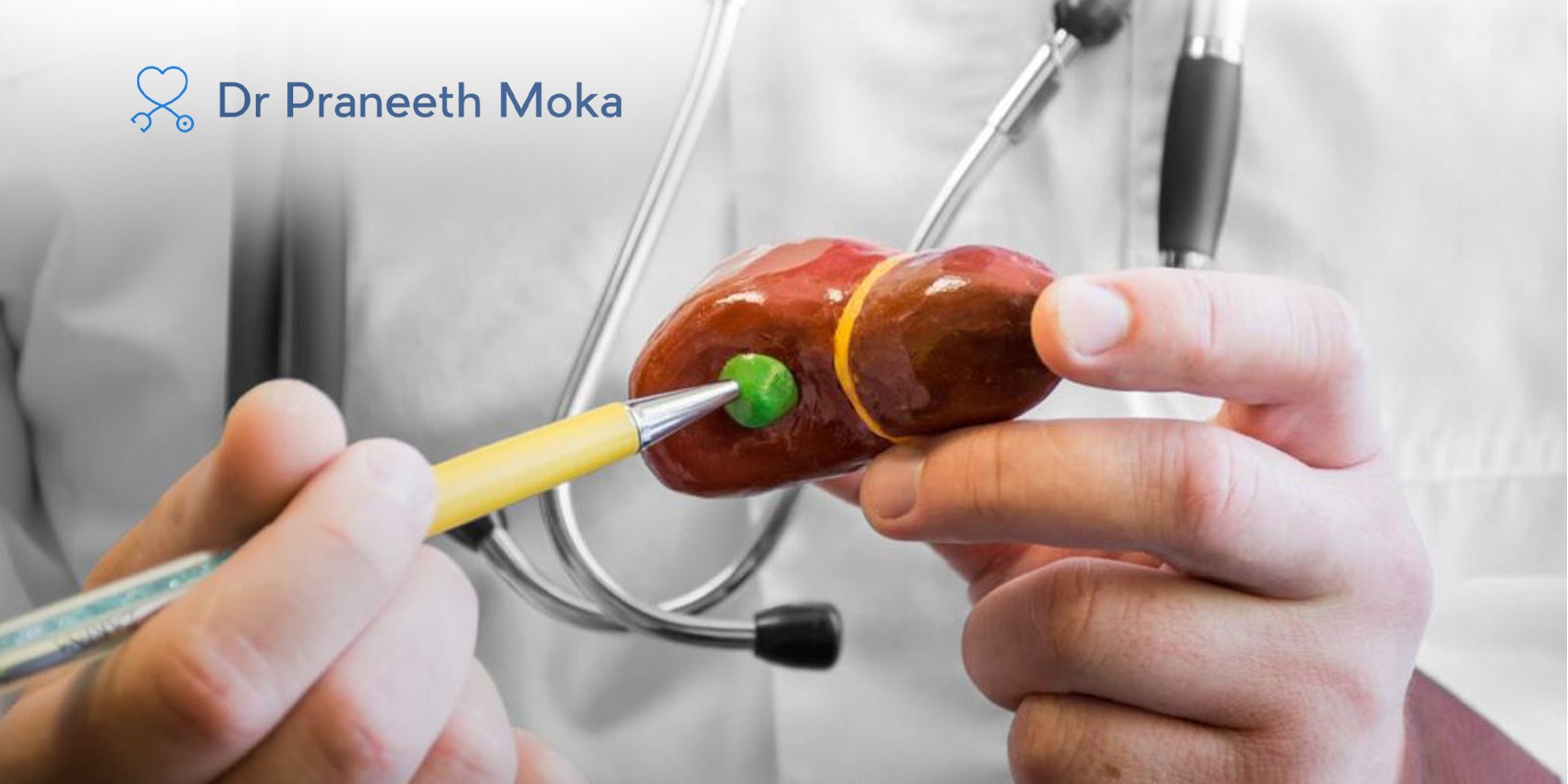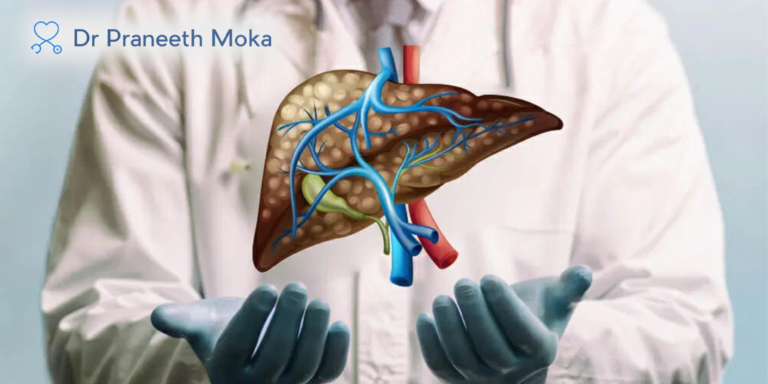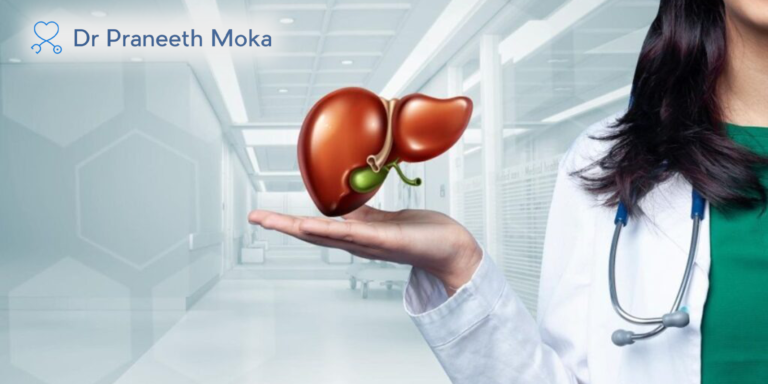Book Appointment Now

6 Major Differences Between Gallstones and Stones in the Bile Duct
Digestive health issues are among the most common reasons for hospital visits today, and one of the frequently misunderstood areas is the presence of stones in the biliary system. Many patients often confuse gallstones with bile duct stones, assuming both are the same. However, understanding the distinction is critical, especially for appropriate treatment and prognosis.
In this comprehensive blog, Dr. Moka Praneeth, a renowned trusted gastroenterologist in Hyderabad, clarifies the key differences between gallstones and bile duct stones. With his vast experience as a Best Gastro Doctor and an acclaimed Liver Specialist In Hyderabad, he emphasizes the importance of accurate diagnosis and timely intervention.
What Are Gallstones?
Gallstones are solid crystalline particles that form inside the gallbladder—a small, pear-shaped organ located beneath the liver that stores and concentrates bile, a digestive fluid produced by the liver. These stones develop when the chemical composition of bile becomes imbalanced. The most common cause is the excessive concentration of cholesterol, but gallstones can also form due to excess bilirubin or insufficient bile salts. Over time, these substances can harden and form stones that vary greatly in size—from as small as a grain of sand to as large as a golf ball. Gallstones may occur as a single stone or as multiple stones, and their composition can also differ; the most common types are cholesterol stones and pigment stones.
Interestingly, many individuals with gallstones remain asymptomatic for years, meaning the stones lie dormant and undetected, often discovered incidentally during imaging studies for other conditions. However, when gallstones obstruct the flow of bile, particularly by blocking the cystic duct or common bile duct, they can trigger a range of distressing symptoms. The hallmark symptom is a sharp, cramping pain in the upper right or middle abdomen, known as biliary colic. This pain may last from a few minutes to several hours and often occurs after eating a fatty meal. Other associated symptoms include nausea, vomiting, indigestion, abdominal bloating, and a feeling of fullness. In severe cases, gallstones can lead to complications like acute cholecystitis (inflammation of the gallbladder), cholangitis (infection of the bile ducts), or pancreatitis (inflammation of the pancreas).
Because gallstone symptoms can mimic those of other gastrointestinal disorders, accurate diagnosis is critical. An ultrasound is typically the first imaging test used to confirm the presence of gallstones. Blood tests may also be ordered to check for signs of infection, inflammation, or bile duct obstruction. For patients experiencing symptoms or complications, treatment options range from dietary modifications to medications that dissolve gallstones, though surgical removal of the gallbladder (cholecystectomy) is often the most effective and permanent solution.
If you are experiencing persistent abdominal discomfort, especially after meals, or have a history of gallstone-related complications, seeking medical attention is essential. A trusted gastroenterologist in Hyderabad can provide a comprehensive evaluation, accurate diagnosis, and tailor a treatment plan based on your unique condition. With advanced diagnostic tools and minimally invasive procedures available today, patients can expect effective relief and quick recovery under expert care.
What Are Bile Duct Stones?
Bile duct stones, medically known as choledocholithiasis, are solid deposits that either originate within the bile ducts or, more commonly, migrate there from the gallbladder. The bile ducts—namely the common hepatic duct and the common bile duct—serve a vital function in the digestive system by transporting bile from the liver and gallbladder to the small intestine, where it aids in the digestion of fats. When stones become lodged in these narrow ducts, they can severely disrupt the flow of bile, leading to a cascade of complications.
Unlike gallstones, which may often remain silent and asymptomatic, bile duct stones tend to produce more immediate and serious health risks. Obstruction of the bile duct can cause intense right upper abdominal pain, jaundice (yellowing of the skin and eyes), dark urine, pale stools, nausea, vomiting, and fever. One of the most concerning consequences of bile duct obstruction is cholangitis, a potentially life-threatening infection of the bile ducts. Additionally, if the stone blocks the pancreatic duct, it can lead to acute pancreatitis, a painful and dangerous inflammation of the pancreas. These conditions often require emergency intervention and hospitalization.
Diagnosis of bile duct stones typically involves a combination of imaging studies and blood tests. While abdominal ultrasound is a common initial test, it may not always detect stones within the ducts. Advanced imaging techniques such as MRCP (Magnetic Resonance Cholangiopancreatography), EUS (Endoscopic Ultrasound), or ERCP (Endoscopic Retrograde Cholangiopancreatography) are often necessary. ERCP not only allows for visualization but also enables therapeutic intervention, such as stone extraction and stent placement to restore bile flow.
According to Dr. Moka Praneeth, a highly regarded trusted gastroenterologist in Hyderabad, the management of bile duct stones requires greater precision and care due to the risk of rapid deterioration and systemic infection. He frequently emphasizes that early diagnosis and minimally invasive endoscopic procedures like ERCP can significantly reduce morbidity and prevent long-term complications.
Given the severity and complexity of choledocholithiasis, individuals who present with symptoms such as jaundice, recurrent abdominal pain, or a history of gallstones should not ignore these warning signs. Consulting a trusted gastroenterologist in Hyderabad is essential to ensure timely investigation and appropriate intervention. With advanced tools and specialized expertise available today, the chances of full recovery are excellent when managed promptly under expert care.
1. Location of the Stones
- Gallstones: Form inside the gallbladder.
- Bile Duct Stones: Found in the bile ducts, especially the common bile duct (CBD).
The location of the stone plays a crucial role in determining the symptoms, complications, and treatment methods. According to trusted gastroenterologist in Hyderabad,- Dr. Moka Praneeth, treating bile duct stones often involves more advanced procedures than managing gallstones.
2. Symptoms and Clinical Presentation
- Gallstones: Typically cause upper right abdominal pain (especially after eating), bloating, indigestion, and nausea. Many gallstones are asymptomatic.
- Bile Duct Stones: More likely to cause severe symptoms like jaundice, fever, chills, and sharp abdominal pain. They can lead to life-threatening infections if not treated promptly.
As a trusted gastroenterologist in Hyderabad, Dr. Moka Praneeth advises patients not to ignore symptoms such as yellowing of the skin or high-grade fever, as these may suggest a blocked bile duct.
3. Risk of Complications
Gallstones can lead to a range of complications, particularly when they block the normal flow of bile from the gallbladder. One of the most common and concerning outcomes is cholecystitis, which is the inflammation of the gallbladder wall. This condition often presents with sharp abdominal pain, fever, nausea, and tenderness in the upper right abdomen, and may require urgent medical or surgical treatment. If left untreated, cholecystitis can progress to gallbladder gangrene, a serious and potentially life-threatening condition where the gallbladder tissue begins to die due to lack of blood supply. In certain cases, a gallstone may slip into the common bile duct and block the pancreatic duct as well, leading to gallstone pancreatitis—a severe inflammation of the pancreas characterized by intense pain, vomiting, and risk of systemic complications.
On the other hand, bile duct stones (choledocholithiasis) pose a significantly higher degree of risk, primarily because of their location within the critical bile drainage system. These stones can obstruct the bile ducts and lead to obstructive jaundice, where bile backs up into the liver and spills into the bloodstream, causing yellowing of the skin and eyes, dark urine, and pale stools. More dangerously, a stagnant bile flow can create an ideal environment for bacterial growth, leading to cholangitis—a potentially fatal infection of the bile ducts that presents with high fever, chills, severe abdominal pain, and confusion. Additionally, just like gallstones, bile duct stones can also cause acute pancreatitis, but with a more complex clinical course and higher risk of complications, including multi-organ failure.
Given the elevated risks associated with bile duct stones, especially when symptoms such as jaundice, fever, or severe abdominal pain are present, timely diagnosis and treatment become critical. Delayed care can quickly escalate into a medical emergency. That is why seeking expert evaluation by a Liver Specialist in Hyderabad such as Dr. Moka Praneeth is strongly advised. Dr. Praneeth specializes in hepatobiliary and gastrointestinal conditions and is known for his expertise in managing complex cases involving bile duct stones and liver-related complications. His approach often includes the use of advanced diagnostic tools like ERCP and MRCP, which not only confirm the diagnosis but also facilitate immediate therapeutic intervention, minimizing risk and ensuring a faster recovery.
4. Diagnosis and Imaging Techniques
- Gallstones: Usually diagnosed via abdominal ultrasound. Easy to detect when present in the gallbladder.
- Bile Duct Stones: Often require more advanced imaging techniques such as MRCP (Magnetic Resonance Cholangiopancreatography), ERCP (Endoscopic Retrograde Cholangiopancreatography), or EUS (Endoscopic Ultrasound).
As a trusted gastroenterologist in Hyderabad,, Dr. Moka Praneeth uses cutting-edge diagnostics at his Hyderabad clinics to ensure accurate detection and staging of both gallstones and bile duct stones.
5. Treatment Approach
- Gallstones:
- Asymptomatic: Often no treatment required.
- Symptomatic: Laparoscopic cholecystectomy (surgical removal of the gallbladder).
- Bile Duct Stones:
- Endoscopic removal via ERCP.
- In severe cases, surgery may be needed.
Since bile duct stones require a more skillful and precise approach, Dr. Moka Praneeth, a trusted gastroenterologist in Hyderabad, often performs advanced endoscopic procedures to ensure safe and effective removal.
6. Post-Treatment Monitoring and Recovery
- Gallstones: Recovery post-cholecystectomy is usually straightforward with minimal complications.
- Bile Duct Stones: Require closer monitoring due to the higher risk of recurrence, infections, and complications.
Patients under the care of Dr. Moka Praneeth, a trusted gastroenterologist in Hyderabad, benefit from detailed follow-up plans that include dietary guidance, liver function monitoring, and periodic imaging.
Common Myths About Gallstones and Bile Duct Stones
- Myth: Gallstones and bile duct stones are always symptomatic.
- Fact: Many cases are silent until complications arise.
- Myth: Surgery is the only option.
- Fact: Endoscopic techniques often suffice, especially for bile duct stones.
- Myth: Once treated, stones don’t come back.
- Fact: Lifestyle, diet, and genetics can influence recurrence.
Understanding these myths empowers patients to make informed, confident decisions about their health and treatment options. It reduces unnecessary fear, promotes timely medical care, and encourages a proactive approach to digestive wellness. That’s why patient education remains a cornerstone of care for Dr. Moka Praneeth, a trusted gastroenterologist in Hyderabad, who believes that informed patients are better equipped to participate in their own healing journey and achieve better outcomes. Through clear communication, evidence-based guidance, and a compassionate approach, Dr. Praneeth ensures that every patient feels heard, understood, and well-informed.
Role of a Gastroenterologist in Diagnosis and Treatment
When dealing with such complex issues, consultation with a qualified and trusted gastroenterologist in Hyderabad is essential. With his vast experience, Dr. Moka Praneeth ensures accurate diagnosis and precision-guided treatment.
His status as a trusted gastroenterologist in Hyderabad is backed by hundreds of successful outcomes and patient testimonials. From basic consultations to advanced ERCP and surgical referrals, he provides a complete spectrum of care.
Importance of Timely Diagnosis
Delays in identifying bile duct stones can lead to severe infections and liver damage. Even seemingly minor symptoms like indigestion or discomfort post meals can be early signs.
Regular health checkups and timely imaging under the supervision of a trusted gastroenterologist in Hyderabad like Dr. Moka Praneeth can save lives and prevent long-term damage.
Patient Education and Support
One of the most valued qualities of trusted gastroenterologist in Hyderabad – Dr. Moka Praneeth is his patient-first philosophy. He believes in:
- Empowering patients with knowledge
- Encouraging lifestyle changes
- Providing psychological support during treatment
His empathetic approach makes him a trusted gastroenterologist in Hyderabad who truly listens and guides his patients through each phase of recovery.
Final Thoughts
While gallstones and bile duct stones may seem similar, they differ significantly in terms of location, symptoms, risk, and treatment. Accurate differentiation and timely care are vital.
If you or a loved one is facing recurring abdominal discomfort, jaundice, or digestive issues, don’t delay. Consult a reputed and trusted gastroenterologist in Hyderabadlike Dr. Moka Praneeth. His multidisciplinary expertise as a Best Gastro Doctor and Liver Specialist In Hyderabad ensures that you receive the highest standard of care.
Choose proactive health management. Reach out to a trusted gastroenterologist in Hyderabad today and take the first step toward a pain-free, healthier life.
Call Us For Appointment: +91 70753 52525
Write a Message: info@drpraneethmoka.com |
Follow us on: praneethgastrocentre




